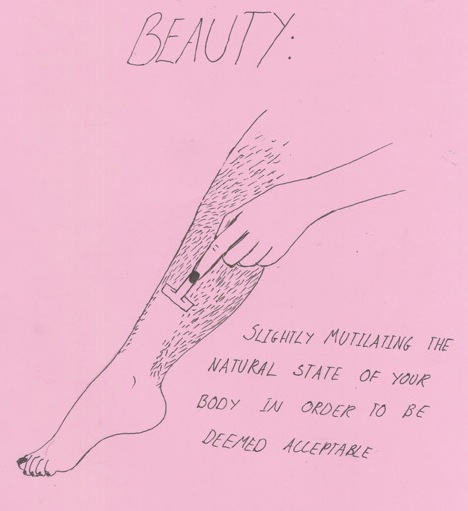Femininity and Domination by Sandra Bartky: In her book Femininity and Domination, Sandra Bartky uses Marx’s theory of alienation to explain the objectification that results from women’s preoccupation with their appearance. She features Marx’s theory of alienation which says the fragmentation of the human person is the “splintering of human nature into a number of misbegotten parts.”
Bartky believes that women in patriarchal societies also undergo a kind of fragmentation “by being too closely identified with [their body]… [their] entire being is identified with the body, a thing which… has been regarded as less inherently human than the mind or personality,” (Bartky 1990, 130). All the focus is placed on a woman’s body, in a way that her mind or personality are not adequately acknowledged. A woman’s person, then, is fragmented. Bartky believes that through this fragmentation a woman is objectified, since her body is separated from her person and is thought as representing the woman (Bartky 1990, 130).
Bartky explains that, typically, objectification involves two persons, one who objectifies and one who is objectified. However, as Bartky points out, objectifier and objectified can be one and the same person. Women in patriarchal societies feel constantly watched by men, much like the prisoners of the Panopticon (where prisoners are never out of the guards sight), and they feel the need to look sensually pleasing to men (Bartky 1990, 65).
According to Bartky, “In the regime of institutionalized heterosexuality, woman must make herself “object and prey” for the man. Woman lives her body as seen by another, by an anonymous patriarchal Other,” (Bartky 1990, 73). This leads women to objectify their own persons. Bartky argues that the woman “[takes] toward her own person the attitude of the man. She will then take erotic satisfaction in her physical self, reveling in her body as a beautiful object to be gazed at and decorated.” Such an attitude is called “narcissism,” which is defined by Bartky as the infatuation with one’s bodily being (Bartky 1990, 131–2).
 In being infatuated with their bodily beings, Bartky argues that women learn to see and treat themselves as objects to be gazed at and decorated, they learn to see themselves as though from the outside. Narcissism, as Simone de Beauvoir also points out, “consists in the setting up of the ego as a double ‘stranger’” (Beauvoir 1961, 375). The adolescent girl “becomes an object and she sees herself as an object; she discovers this new aspect of her being with surprise: it seems to her that she has been doubled; instead of coinciding exactly with herself, she now begins to exist outside,” (Beauvoir 1961, 316). However, this “stranger” who inhabits women’s consciousness, Bartky writes, is hardly a stranger; it is, rather, the woman’s own self (Bartky 1993, 134).
In being infatuated with their bodily beings, Bartky argues that women learn to see and treat themselves as objects to be gazed at and decorated, they learn to see themselves as though from the outside. Narcissism, as Simone de Beauvoir also points out, “consists in the setting up of the ego as a double ‘stranger’” (Beauvoir 1961, 375). The adolescent girl “becomes an object and she sees herself as an object; she discovers this new aspect of her being with surprise: it seems to her that she has been doubled; instead of coinciding exactly with herself, she now begins to exist outside,” (Beauvoir 1961, 316). However, this “stranger” who inhabits women’s consciousness, Bartky writes, is hardly a stranger; it is, rather, the woman’s own self (Bartky 1993, 134).
Foucault on Abnormality
“If you are not like everybody else, then you are abnormal; if you are abnormal, then you are sick. These three categories, not being like everybody else, not being normal and being sick are in fact very different but have been reduced to the same thing,” (Foucault, 1975, pg. 95).
By Lakhpreet Kaur
Read Part 7 Final Words on Shaving
Sources: http://plato.stanford.edu/entries/feminism-objectification/
Michel Foucault, (2004.) ‘Je suis un artificier’. In Roger-Pol Droit (ed.), Michel Foucault, entretiens. Paris: Odile Jacob, p. 95. (Interview conducted in 1975. This passage trans. Clare O’Farrell).






No Comments